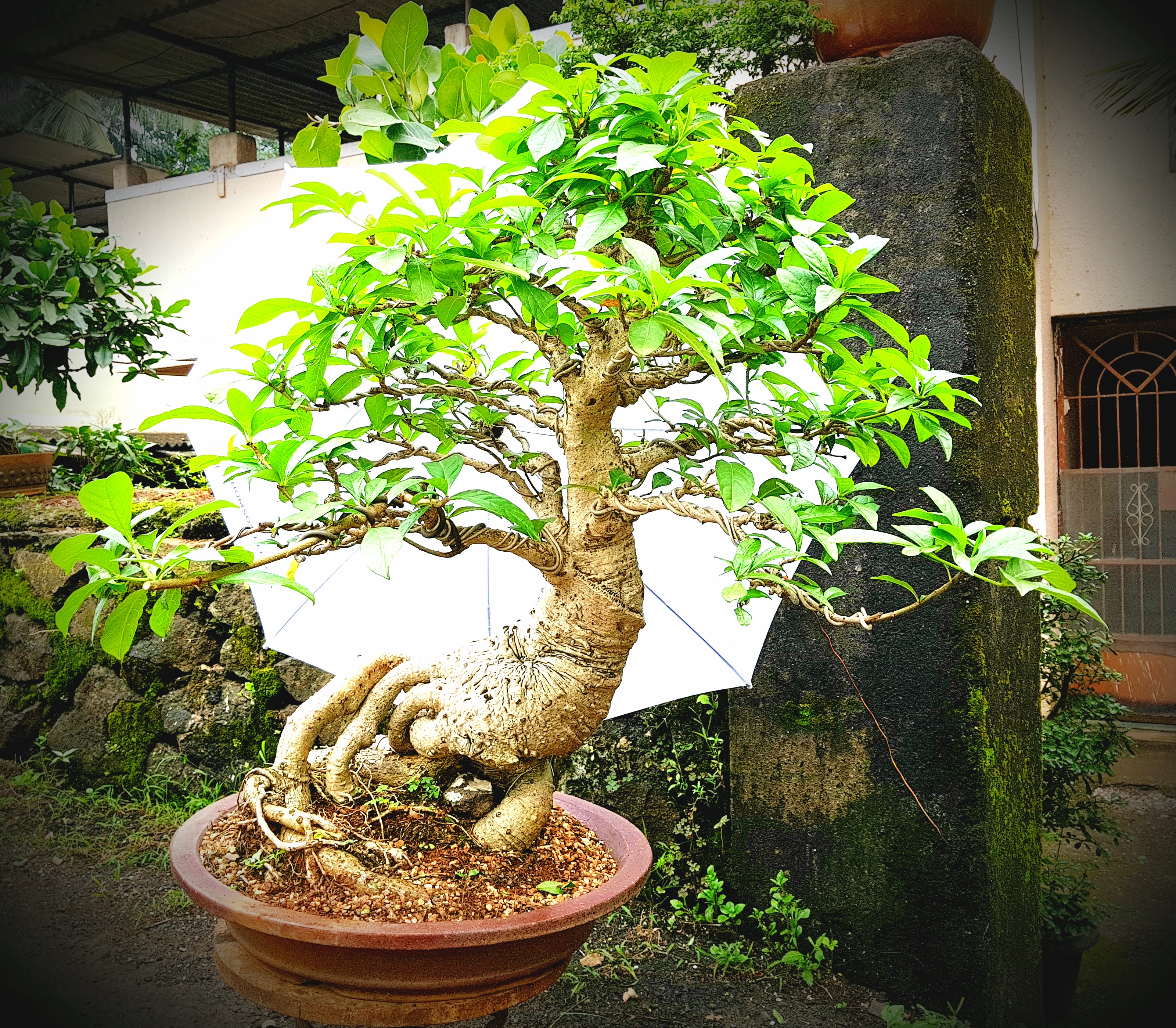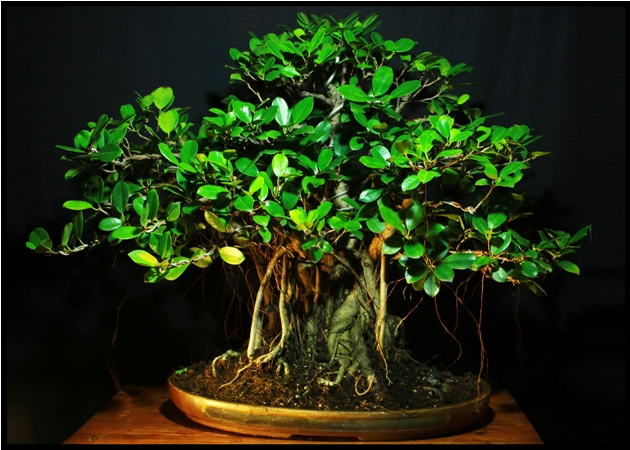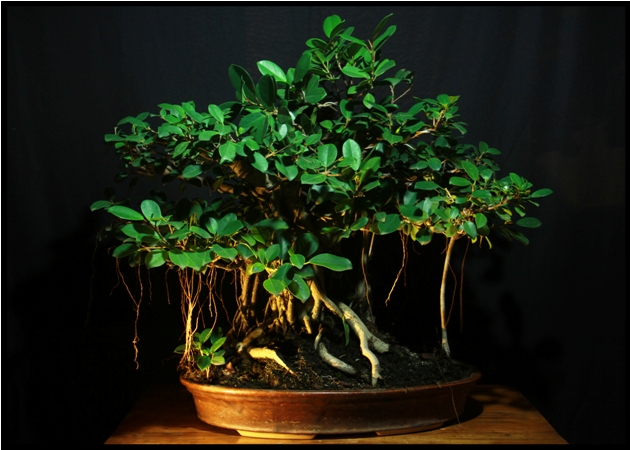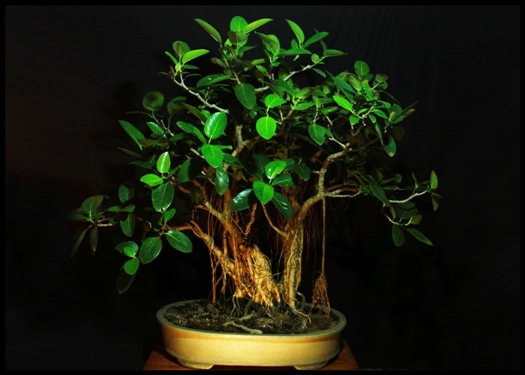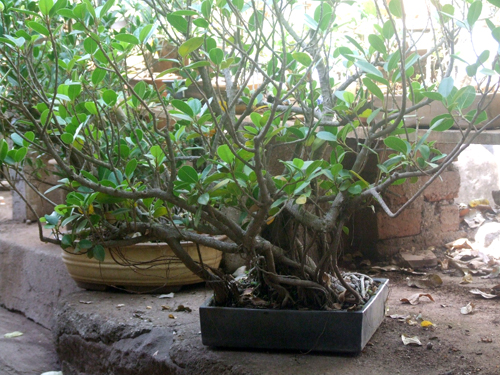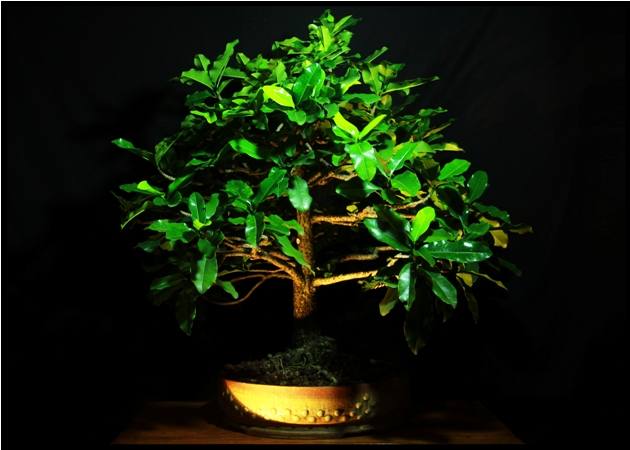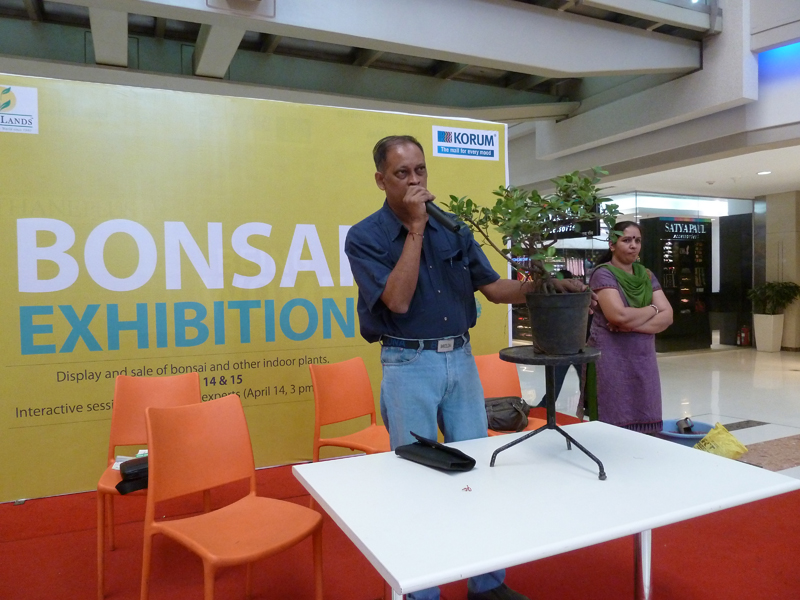The Importance of Nebari or Surface Roots
The three elements comprising the roots (both visible and hidden under the soil), the trunk, the branch silhouette and the external element of the pot or container are integral components of a bonsai. In all these elements, the roots are of prime importance not only because of their bearing on the health and wellbeing of the bonsai (especially the hidden roots), but also because of the direct visual impact of visible sur face roots in the overall bonsai design. In fact the visible sur face roots or “nebari” are the foundation on which the entire superstructure of the bonsai is based. Nebari or Surface Roots Variations in nebari:
1. It is said that first impressions are more lasting than subsequent ones. In bonsai this first impression is created by the Nebari or Surface roots. Strong nebari gives the impression of a strong bonsai and vice versa. The relationship of surface roots with the trunk from the base up decides the impact of the bonsai and, in a manner of speaking sets the pace of the entire composition. Good surface roots which indicates stability and good anchorage (in the soil), although it is the first requirement of a good bonsai, also needs to compliment for the movement of the trunk and the supporting branch silhouette. This is comparable to the position of a batsmans’ feet while playing a particular cricketing shot; if the footwork is at fault, the shot is not executed correctly and lacking the requisite power behind it, does not achieve the desired results.
2. In general, good rootage implies roots which emanate from nearly the same level and which generally radiate in all directions from the base of the trunk, caliper vis-a-vis the trunk thickness, tapered disappearance into the soil without appearing to be hanging. Usually, there shouldn’t be any surface roots in the front of the trunk directly facing the viewer. However, because trunk movement and configuration of branches are distinctive in the different styles of bonsai, there are subtle differences in the movement of the roots in each style. For example, in the ca se of upright styles where a trunk is perpendicular to the soil level (Formal Upright and Broom styles), the visible surface roots also need to appear almost linear with an almost equal caliper and to radiate in all directions, tapering to disappear into the soil; but the roots on the left and right axes would, however, extend slightly more than those at the back, mimicking the later al spread of the branches. This will also be the case with the plants in a group planting, although their roots will tend to be shorter due to the tighter placement of the several trunks; roots of the peripheral trunks will, however, be seen to spread outwards towards the sides of the pot. (Fig. 1, 2 & 3 – Rootage of the Formal Upright, Broom and Forest styles)



3. In the case of upright styles with slanted or twisted trunks (Slanting, Informal Upright, Windswept styles) although the surface roots would radiate in all directions they would be tortuous & snaky and with unequal thicknesses. Where the trunk leans in a particular direction, the major visible root/s on the side opposite the lean will appear to be stronger but expressing a tension as if counter – balancing the pull of the lean; the root/s on the side of the lean, on the other hand will appear sprung as if compressed to support the visual mass of the branches and foliage. The design of the bonsai, in the curves of the trunk and the springy sweep of the branches would be but a reflection of the tension and compression of the surface roots; only this will lend conviction and strength to the overall composition. Sometimes the effect is exaggerated by exposed roots which coil sinuously under the trunk like the legs of a prehistoric monster.
(Fig. 4 – Rootage of the Informal Upright and Slanting styles)
 4. In the case of Bunjin, Cascade and Semi-cascade styles, the roots will appear more compressed, given the narrower mouth of the pot, although the roots opposite the direction of the lean of the bunjin style or cascading trunk might just appear to be stronger to counteract the lean or fall of the trunk.
4. In the case of Bunjin, Cascade and Semi-cascade styles, the roots will appear more compressed, given the narrower mouth of the pot, although the roots opposite the direction of the lean of the bunjin style or cascading trunk might just appear to be stronger to counteract the lean or fall of the trunk.
(Fig. 5 & 6 – Rootage of the Cascade, Semi-cascade and Bunjin styles)


5. In both, the informal styles and the cascading styles, the twisting appearance of the roots is therefore both functional as well as artistic. A critical design balance is achieved through this impression of the nebari or surface roots. This aspect is succinctly expressed thus by Carl Bergstrom, USA, ” the logical explanation …. of the structure (of a bonsai) must be consistent in both a physical sense and in an artistic sense. Tension requires must be consistent in both a physical sense and in an artistic sense. Tension requires obedience (?) and compression requires release. How these dynamics are accounted for in the overall design is how we must measure the success or failure of the root configuration of a bonsai”.
6. Encouraging good rootage:
It is difficult to obtain plants with ideally arranged roots. More often than not one gets plants with defective rootage only, especially if the plant is a collected one. Most times, if a bonsai is to be created out of nursery grown material, the chances are that the roots will be abundant but it will probably take years to develop good surface roots compatible to the style in which the bonsai is designed. This is usually done by exposing the surface roots a little more during each successive repotting.
7. Corrections to defects in nebari: The defects in nebari are usually in the form of: a) lack of roots at certain points; b) poor or thin rootage; c) abnormal roots or too thick roots. In such cases, corrective measures need to be adopted in order to maintain the impression of a particular style.
For trunks lacking rootage from certain points – initially attempts should be made to encourage new roots by making cuts at the places de void of roots and dusting these places with rooting hormones or if that fails or if the variety is hard to root, root correction in the form of grafting the roots of a donor plant or grafting a donor plant at a place devoid of roots should be tried. If even then roots fail to emerge, then a rock or a tuft of decorative grass can be placed at the point lacking rootage. Poor rootage can also be corrected in the same way.
8. Abnormal as also hanging roots should be removed entirely if substitute roots are already available at suitable places lower down. Alternatively, they can be stapled down or in extreme circumstances wired into the desired shape. Overly thick roots can be split along their lengths and the resultant wounds sealed with a suitable sealant.
9. In some cases, lack of rootage can be corrected by changing the potting angle and modifying the branch structure and opening up the foliage wherever necessary to suit the new design.

10. However, in a case where roots are misshapen beyond salvage or only a single heavy root exists, the trunk just above the soil surface can be gouged or scoured in selected placed, rooting hormones applied in these places and the trunk at ground level is enveloped in a wall or well of netting and the space is filled with coarse sand or well-drained soil and watered well; the well can be gradually removed when new roots emerge and are strong enough to replace the old roots.

11. The caliper growth of thin or weak but ideally placed surface roots can be hastened by leading them into hollow plastic or bamboo pipes or tubes filled with gr owing media (soil and compost in equal proportions) which are in turn led into the ground. But this is an advanced technique that has to be tried on bonsai which are already in a mature stage.
12. To sum up, since nebari or visible surface roots are the basis on which the other elements viz., the trunk, branches and foliage depends for the impression of a convincingly mature image in bonsai, it is important that particular attention needs to be paid to their development and artistic arrangement in the bonsai pot, failing which the bonsai, however developed it may be, will not make the intended visual impact and style statement. Following are some photos of the nebaris of some of my own bonsai. Each nebari pic is followed by the actual tree in order to show the relationship between the surface roots and the style of the tree. Admittedly, most of them still need a lot of refinement, but that is the beauty of cultivating bonsai: they are never finished and therefore of constant interest and joy in their changing imagery.


Nebari of Banyan (Ficus Benghalensis) and full view


Nebari (left) and full view (right) of the Wrightia (Wrightia Religiosa)


Exposed roots style nebari of Baobab (Adansonia Digitata) on left and full view
 On
On left – Nebari of Manilkara
left – Nebari of Manilkara
(Manilkara Hexandra) On right – full view of M. Hexandra
 Banyan (Ficus Benghalensis) Left photo showing nebari
Banyan (Ficus Benghalensis) Left photo showing nebari 
and Right photo showing the huge bonsai in full
 Baobab (Adansonia Digitata) nebari photo on the left. Same tree full view on right.
Baobab (Adansonia Digitata) nebari photo on the left. Same tree full view on right.
Acknowledgements & References:
1 – “Superior Rootage- The starting point of your masterpiece” by Jerry Meislik in the BCI Magazine Vol. XXIX No.3, May/June 1990;
2 – “Artistic Composition and the Position of an Asymmetrical Nebari” by Carl Bergstrom, USA, in the Art of Bonsai website, 2012.
3 – Occasional Critiques by Robert Stevens on the Stone Lantern blog.
4 – My researches and my article entitled “Perceptions & Perspectives in Bonsai Design” on my own website “ruchabonsai.com “.

